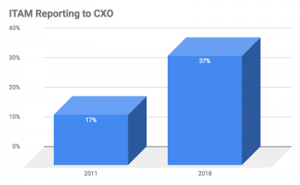New global trade body announced to push the ITAM industry forward

A new trade body for the advancement of the ITAM industry
ITAM teams enjoy more seniority and board level exposure than ever before. Research by The ITAM Review in 2018 suggested that ITAM teams reporting into the CXO has increased from 17% in 2011 to 37% in 2018.
“ITAM is ascending in seniority and non-IT attention. Out of the shadows of operational process and configuration management (45% reporting into ITSM in 2011) to the limelight of the C-suite (37% CXO in 2018). As we fast approach the 2020s, smart management of assets is a shrewd business practice with benefits well beyond IT. Bye-bye software compliance, hello competitive advantage in ability to execute IT.”
Source: ITAM Review 2018 Reader Survey
 I believe there are two primary reasons behind this trend:
I believe there are two primary reasons behind this trend:
- IT has become more critical, transitioning from a function to something that weaves its way through the fabric of an entire organisation. From a team in the basement to a platform underpinning the whole business.
- The buyers of IT are no longer just in the IT department
The net result is ITAM has increasing board level exposure and senior management scrutiny. Back in 2016, Gartner suggested SAM was a “C-Level” imperative (source). How does an ITAM department prove the value of its output? Especially when some of its stakeholders don’t even know what ITAM means (counting computers, right?), let alone know how to quantify it.
An ISO standard is one such way of proving the quality of your output and demonstrating your value, increasing the credibility of ITAM teams. First published in 2006, there is no formally recognised way of certifying your organisation against the ISO19770 standard.
A new trade body intends to deliver this certification process.
A professional body for the advancement of the IT Asset Management Industry
A new trade body is being launched with two specific objectives:
- To be a caretaker of the new organisational certification program to allow organisations to demonstrate the quality of their ITAM practices
- To educate and evangelise – to encourage more companies to do ITAM and to attract new professionals into the industry
To ensure that this trade body is relevant, practical and useable, it will be overseen by a trustee board of end user ITAM professionals. ISO standards, at their core, are industries coming together to measure what good looks like for the advancement of their industry. They should not be a dusty academic exercise, but something for a company to aspire to in return for tangible bottom line benefits.
Certifying organisations against the ISO standard provides the highest measure of quality to demonstrate the competence of an ITAM department in the face of this increasing board level scrutiny. By benchmarking ITAM department output against ISO standards, stakeholders in the ITAM lifecycle, perhaps not fully versed in the complexity of IT assets, can be assured of quality.
Why would anyone want to get certified against the standard anyway?
Ultimately, organisational certification against the ITAM ISO standard is about demonstrating good governance. This good governance can be demonstrated to both internal and external stakeholders:
- Internal Validation – Internal validation shows to your immediate team, management team and internal stakeholders, via an independent global ISO standard, the level of quality delivered by your ITAM function. This proves the quality of your ITAM services and helps raise the profile and reputation of your team. Internal validation also proves, by unequivocal independent standard, to Internal Audit and subsequently the Board of Directors, that your organization is demonstrating good governance and management of risk.
- External Validation – The second major business benefit of organisational certification against the ITAM standard is external validation. Organisational certification sends a very strong message to the vendors you are working with that you are executing ITAM at a very high level. Otherwise, the competence and quality of your ITAM team must be demonstrated with bravado. ISO provides an independent, verifiable level of quality that you can send to the vendor ecosystem supplying your organization.
By certifying, an organization sends a strong message to its software publishers, partners, hardware manufacturers, service providers and other stakeholders that it takes the management of IT assets very seriously and delivers ITAM services to a high standard. A great foundation to strong vendor management, negotiation and market perception.
ISO certification represents an opportunity for avoiding or thwarting audits. Why would a manufacturer or vendor want to audit your organization for potential mismanagement of a contract when an independent measure of quality has been completed? Organisations certifying against the ITAM standard would be in a position to negotiate the removal of audit clauses or supply proactive self-declarations. ISO certification also supports the strong management of hardware assets – especially regarding environmental impact and data management concerns. Organisations face punitive damages from the mismanagement of hardware based on data protection regulation such as GDPR or e-waste legislation.
Software publishers should recognise and reward organisations certifying against ITAM standards, which significantly reduces the risk of non-compliance and reduces the friction created by audits and licensing conflicts. In turn, certified organisations should be recognised for their leadership in the ITAM industry and should negotiate favourable terms based on their high level of commitment and demonstration of quality. Finally, ITAM departments certifying against the ITAM standard are sending a clear message to the ITAM community of their commitment and investment in ITAM, which is likely to make it easier to attract high quality team members into their teams in the future.
Internally, ISO certification of your ITAM practice provides proof to your Board, shareholders, and other senior stakeholders that your IT assets are being managed with the same vigour and care applied to your financial and physical assets.
New ITAM Industry Trade Body – Summary
Objectives
- Raise the profile of the IT Asset Management profession
- Increase the number of organisations with an ITAM practice
- Encourage more professionals to join the profession
- A caretaker for the implementation of ISO standards
- Increase professionalism and push the industry forward
Guiding principles
- Not for profit and independent
- A safe place for end user companies, partners, publishers and manufacturers
- Constructive and collaborative
- Led and governed by end users – To decide goals, ensure relevance and practicality, governance
Measures of success*
- Evangelism of the ITAM profession
- Number of certified partners
- Number of certified organisations
- Real life implementations and success stories
- Quantified ITAM industry size and growth
Milestones*
- Recruitment of trustees (September – November 2019)
- Recruitment of sponsors (November 2019 – January 2020)
- Trade body launch (February 2020 – April 2020)
- Web presence and brand launch (April 2020 – June 2020)
- ISO certification pilot groups – (June 2020 onwards)
- Partner Certification – (TBC)
- Organisational certification – (TBC)
Industry Participation
- End user organisations with mature ITAM practices or aspiration for building a modern ITAM practice
- Partners, service providers or tool manufacturers who want to see the industry develop and expand
- Software publishers and manufacturers who work collaboratively with their customer to improve management of IT assets
(*- To be determined by the board of the new trade body)
Call for participants – Trustee board
I’m seeking the support of end user ITAM professionals to volunteer on the board of this new trade body. We already have a good number who have volunteered, this is a call for any additional volunteers.
Why get involved?
- Make your individual contribution towards pushing the ITAM industry forward
- Unrivalled international networking
- Set quality and professionalism standards for the ITAM industry
- Low time commitment
To discuss further please contact me.
Stay tuned to the ITAM Review Newsletter for further updates on this new iniative.
Can’t find what you’re looking for?
More from ITAM News & Analysis
-
ITAMantics - April 2024
Welcome to the April 2024 edition of ITAMantics, our monthly news podcast where we discuss the biggest ITAM stories from the last month. George is joined this month by AJ Witt and Ryan Stefani. Stories tackled ... -
Broadcom is removing expired VMware licences from its portal - take action now!
Hot on the heels of Broadcom’s announcement of the end of perpetual licences for VMware it has given customers barely a week to download any keys for licenses from its portal with expired support. This is ... -
Who Loses When Broadcom Wins?
News of a new Broadcom deal rarely arrives with great fanfare. The November 2023 VMware acquisition provoked open worry online and in business circles, with many critics wondering whether the former Hewlett-Packard spinoff’s reputation would prove ...